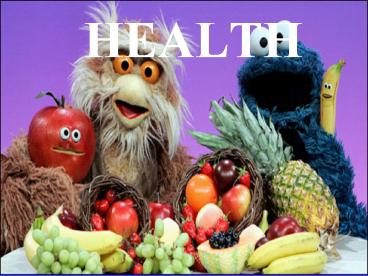HEALTH PowerPoint PPT Presentation
1 / 32
Title: HEALTH
1
HEALTH
2
- Health
- A range of states with physical, mental,
emotional, spiritual, and social components. - Wellness
- optimal health the top of the range of health
states
3
Group Activity
- Refer to activity 1 (Using page 5 in text)
- Define station
- Add characteristics/ examples to each dimension.
- Evaluate how it would effect you, your family,
and/ or society.
4
Factors that affect Health Status
- Using p. 6-9 in the book, Evaluate how your life
is impacted by the factors that affect health
status.
5
- Chronological Age actual age in years
- Physiological Age estimated age from bodys
health and life expectancy
6
Life Expectancy
- Complete the How long will you live activity to
evaluate the impact of internal and external
factors on you life expectancy (Refer to Activity
2)
7
Quality of Life / Life Expectancy
- 1. Getting adequate Sleep
- Newborn needs 17-18 hours
- 5 yrs. 10-12 hours
- avg. young adult needs about 8 hours
- elderly need less REM sleep
- NREM body is slowed down
- REM deep sleep, dreams
8
(No Transcript)
9
Sleep disorders
- Insomnia difficulty falling or staying asleep
- Narcolepsy when people fall asleep
- suddenly
- Sleep Apnea relaxation of tongue causes
breathing difficulty
10
2. Good Nutrition
- Overweight Obesity
11
(No Transcript)
12
3. Physical Activity
- 220 your age max heart rate
- Target Heart Rate
- 70 of MHR to 85 of MHR
- It is best to improve cardiovascular and cardio
respiratory health
13
(No Transcript)
14
- 4. Avoid tobacco, drugs, and use alcohol in
moderation (if over 21) - 5. Mental Health
- Learn to cope
- Find time to have fun
- spend time with friends/family
- Limit stress
- 6. Avoid Dangerous situations
- aware of accidents, injury and violence
- Aware of STI/STD
15
Health Behavior Inventory
- Refer to p. 28-31
- Can help you become aware of healthy behaviors
that you already practice and discover new habits
that could improve your health status.
16
BEHAVIOR CHANGE
- Motivation the force that moves people to act
- Two types of motivation
- 1. natural (drives or instincts)
- 2. learned
- intrinsic
- extrinsic
- Commitment A long term decision made(a promise
kept)
17
Behavior Change Activity
- Examine an unhealthy behavior
- Explain how you could apply a change in your
behavior and decision making to improve your
health
18
Being a smart consumer
- When using/buying health products it is important
to research, become educated, and know how to
differentiate false advertising from credible
facts
19
Consumer Assessment
- After viewing an advertisement, evaluate the
impact the advertisement has on the average
consumer - Credibility?
- Purpose of Ad?
- Who should buy?
- What psychological approach was used to sell the
product? - How would you change the Ad to benefit the
consumer?
20
Environmental Health
- Federal Acts to Regulate the Environment
- Refer to p. 600-606 (charts)
- Scenario
- use the chart to identify the acts that were
violated and create a more environmental friendly
alternative
21
Safety
- Accidents are the leading cause of death for
- people age 15 - 24
- 2 homicide
- 3 suicide
- Injuries from preventable accidents claim more
- young lives than do disease.
- Spontaneity vs. Caution
22
Highway Accidents
- One Half of all accidents are car accidents
- Of all accidents, car accidents is the 1 killer
in people aged 15 24 - Defensive Driving
- Every driver will encounter other drivers
- who are careless. Defensive driving saves
- lives.
23
Falls
- Falls - 2nd most cause of accidental deaths
- home
- --- Falls are the leading cause of accidental
death in older people - --- Also claims a lot of infants lives
24
- Child Safety
- --- Make sure areas are free of
- hazards that could cause falls.
- --- There should be no water deep enough for
- a child to drown.
- --- No sharp objects around (glass)
- --- All guns should be locked away
- (everyone educated)
25
- --- Childrens food in small pieces no light
- foods
- --- Water should not be hot water heaters
- should be less than 120 degrees F
- Refer to p. 254 ( child sitting)
26
Fires and Burns
- Burns - 3rd leading cause of accidental deaths
- Fire Escapes
- - alarms
- - rescue and exiting
- Baby-sitters
27
Drowning
- Drowning - 4th leading cause of accidental
- death
- 2nd leading cause of accidental death in teens
- Almost 50 of all drownings are alcohol related
- Personal Flotation Devices - should be present
- on all boats
28
Violence
- Refer to p. 657-659
29
- Assault - one persons attack on another with the
intent to do harm - Rape Prevention
- Street Rape - sexual assault by a stranger
- Date Rape/Acquaintance Rape - sexual
- assault with a known person
- Refer to p. 687
30
- To Avoid Rape
- - avoid going out alone in the dark
- - running alone is not smart
- - always ask who is at your door
- - carry pepper spray
- - get keys out before you get to your car
- - carry a whistle
- - keep car maintained
31
- If Approached
- - scream fire
- - pull a fire alarm
- - break a window
- - key in eyes
- - urinate or vomit
32
What not to do when raped?

